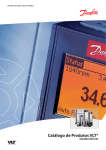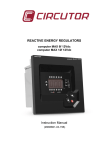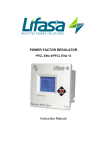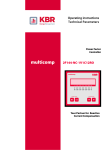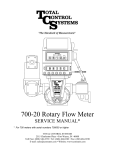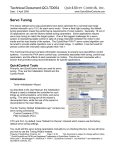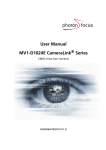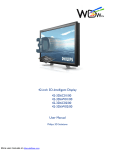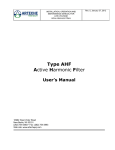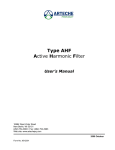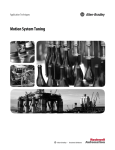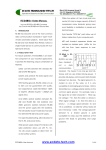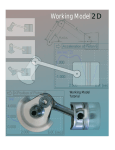Download MSc Active Harmonic Filter MSc AHF 100 Product
Transcript
MSc AHF 100 – Product overview 1.0 (subject to changes without notice) MSc Active Harmonic Filter MSc AHF 100 Product Overview subject to changes without notice 1/28 MSc AHF 100 – Product overview 1.0 (subject to changes without notice) 2/28 1 TERMS AND ABBREVIATIONS ............................................................................................................................. 3 2 TECHNICAL INFORMATION................................................................................................................................. 4 2.1 TECHNICAL DESCRIPTION ................................................................................................................................... 4 2.1.1 Introduction ........................................................................................................................................... 4 2.1.2 Technical data........................................................................................................................................ 5 2.1.3 Ambient conditions................................................................................................................................. 6 2.1.4 Operational description and functions .................................................................................................... 7 2.1.4.1 2.1.4.2 2.1.4.3 2.1.4.4 Overall functional description.........................................................................................................................7 Control functions, input I/O............................................................................................................................8 Output I/O, indicator LEDs..............................................................................................................................8 Current transformers, mains and the neutral for control circuitry....................................................................8 2.2 CONTROL OF MSC AHF 100 ............................................................................................................................. 9 2.2.1 LED indicators......................................................................................................................................... 9 2.2.2 Control interface - inputs and outputs....................................................................................................10 3 MECHANICAL INSTALLATION.............................................................................................................................11 3.1 3.2 3.3 4 WALL MOUNTING ..........................................................................................................................................12 FLANGE MOUNTING ........................................................................................................................................14 COOLING......................................................................................................................................................15 ELECTRICAL INSTALLATION................................................................................................................................16 4.1 POWER CONNECTIONS .....................................................................................................................................17 4.1.1 Selection of the power cable size............................................................................................................17 4.1.2 Making the power connections..............................................................................................................17 4.2 CURRENT TRANSFORMERS ................................................................................................................................19 4.2.1 Selection of current transformers and current transformer cables ..........................................................19 4.2.2 Current transformer installation and connection ....................................................................................22 4.2.3 Current transformer cable interconnection.............................................................................................25 4.3 CONTROL CONNECTIONS ..................................................................................................................................26 MSc AHF 100 – Product overview 1.0 (subject to changes without notice) 1 3/28 TERMS AND ABBREVIATIONS Term/Abbreviation cover CT I/O connections Manufacturer MSc AHF 100 Explanation There are two covers: One protecting the power connections (cable connection box cover), the other hiding the control and CT connections (front cover). current transformer, current sensor digital in- and output connections for ON/OFF/RESET input, Current Limit and Fault output MSc Electronics OY MSc Active Harmonic Filter 100A 3-wire 400Vac (AHF100-3W400) MSc AHF 100 – Product overview 1.0 (subject to changes without notice) 2 2.1 4/28 TECHNICAL INFORMATION Technical description 2.1.1 Introduction MSc AHF 100 is an active filter, which can be used to filter network harmonic currents. The MSc AHF 100 is designed for both industrial and commercial environments. MSc AHF 100 – Product overview 1.0 (subject to changes without notice) 2.1.2 Technical data Electrical data Compensation current capacity Mains nominal voltage Nominal frequency Number of phases Connection type Switching frequency Modularity Response time Current measurements Power dissipation Noise level I/O connections Potential free relay contact Digital input Mechanical data Dimensions (wxhxd) Weight Cooling Operation temperature/ Cooling air temperature Enclosure Standards EMC immunity EMC emissions Electrical safety Protections and warnings Protections Warnings 100 A 208 V, 400 V, 440 V, 480 V +/- 10 % (exception: 480 V +5%) 50/60Hz 3 3 phase without neutral for the mains connection + PE neutral connection is needed for the control circuits 10 kHz parallel connectable without limitation <1 ms 3 x 200 A/5 A / 3 VA CT inputs <3% of the rated power <80 dB Fault, 24 Vdc/ 230 Vac, 2 A Current Limit, 24 Vdc /230 Vac, 2 A ON/OFF/RESET 285 mm x 919 mm x 344 mm 58 kg forced air cooled -10 °C - +40° C IP 20 EN 61000-6-2 EN 61000-6-3 EN 61800-5-1 Inverter overtemp Mains overvoltage Phase fault Overcurrent DC-link overvoltage LCL/CAP overvoltage Inductor overtemp Mains undervoltage Current limit 5/28 MSc AHF 100 – Product overview 1.0 (subject to changes without notice) 6/28 2.1.3 Ambient conditions The MSc AHF 100 is suitable for indoor wall-mount installation, in a well-ventilated area without dust and excessive aggressive gases where the ambient operating conditions do not exceed the following values: Ambient operating temperature/Cooling temperature Storage/transportation temperature (in the protected package) Relative humidity Cooling air required Air quality / chemical vapours Air quality / mechanical particles Altitude Vibration Shock air -10C…+40C -40C…+70C 0 - 95% RH, non-condensing, non-corrosive, no dripping water 650 m3/h IEC 721-3-3, MSc AHF 100 in operation, class 3C2(a) IEC 721-3-3, MSc AHF 100 in operation, class 3S2(b) 100 % load capacity (no derating) 1000 m 1 % derating for each 100 m above 1000 m; max. 3000 m 50 ... 150 Hz, EN50178 / EN60068-2-6 EN50178, EN60068-2-27. Storage and shipping max 15G/11ms (in the protected package). Remarks: (a) Locations with normal levels of contaminants, experienced in urban areas with industrial activities scattered over the whole area, or with heavy traffic. (b) Locations without special precautions to minimize the presence of sand or dust, but not situated in proximity to sand or dust sources. The MSc AHF 100 installation must be indoors and it should be taken into account that the protection class is IP 20IP 20IP 20. WARNING: Conductive dust may cause damage to this equipment. Ensure that the MSc AHF 100 is installed in a room where no conductive dust is present. MSc AHF 100 – Product overview 1.0 (subject to changes without notice) 7/28 2.1.4 Operational description and functions 2.1.4.1 Overall functional description The MSc AHF 100 is designed to compensate harmonic currents (3rd -50th order) drawn from the mains. The MSc AHF 100 measures the load harmonic currents with three current sensors CT1 - CT3 (see block diagram below) and injects opposite polarity harmonic currents of the same amplitude into the mains thus minimizing the amount of harmonic currents drawn from the mains. Asymetrical load transient currents, such as transformer inrush currents, may activate LCL/CAP overvoltage, Overcurrent or DC-link overvoltage faults (see LED indicators). These faults are reset automatically after approx. 12 seconds. A peak output current over 140 A peak is not recommended, even though the MSc AHF 100 is capable to give 150 A peak current output. If the recommended current limit is exceeded, other control functions may not work properly and faulty operation of the MSc AHF 100 may occur. MSc AHF 100 – Product overview 1.0 (subject to changes without notice) 2.1.4.2 8/28 Control functions, input I/O The MSc AHF 100 ON/OFF/RESET states are controlled by physical ON/OFF/RESET switch, which is connected to the digital input X1:1-2 I/O connector. (See chapter 10.2.5 for further details on the switch.) Faults can be reset manually by changing the ON/OFF/RESET digital input from ON to OFF to ON. The reset happens when the input turns from OFF to ON. The MSc AHF 100 also does automatic resets. (For more details on manual and automatic resetting see user manual.) See block diagram in chapter 2.1.4.1. 2.1.4.3 Output I/O, indicator LEDs When the MSc AHF 100 has to limit its harmonic compensation current, X4:1-2 is activated (contact is closed). Further details on when this happens, see information on Current limit LED indicator in chapter 2.2.1 and information in the user manual. When a fault occurs or the ON/OFF/RESET input is in the OFF state, the potential-free output relay contact X11:1-3 closes and X11:1-2 opens. One or more LEDs light up on the front cover. The fault causes and corrective actions are explained in the relevant chapter further below. If no fault is active and the ON/OFF/RESET input is in the ON state, or the mains is off, the contact X11:1-3 is open and the contact X11:1-2 is closed. See block diagram in chapter 2.1.4.1. 2.1.4.4 Current transformers, mains and the neutral for control circuitry In order to put the MSc AHF 100 into operating condition, three load current sensors CT1 – CT3, the ON/OFF/RESET input, the protective earth and the AC mains cables L1-L3 have to be connected. The mains N cable is connected to the control electronics. The neutral is not needed for the mains circuitry, but a thin cross section (1.5 mm2) neutral connection is needed for the control circuits of the MSc AHF 100. See block diagram in chapter 2.1.4.1. MSc AHF 100 – Product overview 1.0 (subject to changes without notice) 2.2 9/28 Control of MSc AHF 100 2.2.1 LED indicators The LED indicators give you information on both fault and normal situations. For corrective actions and more detailed information see user manual. LED indication Control OFF Inverter overtemp Mains overvoltage Phase fault Current limit Start sequence Power ON Overcurrent DC-link overvoltage LCL/CAP overvoltage LED status and colour on (red) blinking (red) on (red) on (red) on (red) on (yellow) on (yellow) on (green) off on (red) on (red) on (red) Inductor overtemp Mains undervoltage on (red) on (yellow) Inhibit on (yellow) Meaning MSc AHF 100 switched off see text for LCL/CAP overvoltage MSc AHF 100 stopped, inverter temperature limit exceeded MSc AHF 100 stopped, mains nominal voltage exceeded MSc AHF 100 stopped due to missing phase or abnormally low (less than 50% of nominal) mains voltage MSc AHF 100 has reached its maximum output current, or the inverter temperature is abnormally high. MSc AHF 100 just connected to mains which normally starts the precharging or mains voltage abnormally low. MSc AHF 100 stopped normal operation no auxiliary power MSc AHF 100 stopped due to abnormal overcurrent MSc AHF 100 stopped, DC-link voltage limit exceeded MSc AHF 100 stopped, DC-link capacitor overvoltage or LCL filter capacitor overvoltage (if Control OFF LED is blinking (1Hz) at the same time) MSc AHF 100 stopped, internal inductor temperature limit exceeded. MSc AHF 100 stopped. Mains voltage abnormally low (less than 80% of nominal). MSc AHF 100 stopped MSc AHF 100 – Product overview 1.0 (subject to changes without notice) 10/28 2.2.2 Control interface - inputs and outputs The control connections are the following: X1 control input/output technical information terminal +24Vdc output on/off/reset control voltage 1 on/off/reset input on/off/reset input 2 CT1 s1 L1 load current transformer input 3 galvanically isolated from PE and control CT1 s2 4 5 6 CT2 s1 CT2 s2 7 8 CT3 s1 CT3 s2 9 Mains neutral connection electronics L2 load current transformer input galvanically isolated from PE and control electronics L3 load current transformer input galvanically isolated from PE and control electronics Mains neutral connection for control electronics. This is not a power connection. specification max 50mA Uin max 24Vdc+10% 3VA 200/5A recommended cable crosssection 2.5mm2 recommended cable crosssection 1.5 mm2 X4 current limit output technical information specification terminal NO relay contact Current limit output. Potential free relay contact, 2A / 24Vdc / 230 Vac 1-2 galvanically isolated from PE and control electronics. This contact is closed when current limit is activated. X11 fault output COM 1 NC relay contact 2 NO relay contact 3 technical information specification Fault output. Potential free relay contact, galvanically isolated from PE and control electronics. Contact 1-3 closes when any fault is active. 2A / 24Vdc / 230 Vac MSc AHF 100 – Product overview 1.0 (subject to changes without notice) 3 11/28 MECHANICAL INSTALLATION Please note the weight of the MSc AHF 100 (see chapter 2 TECHNICAL INFORMATION). Care should be taken to ensure that correct handling facilities are used. The MSc AHF 100 may only be lifted with a steel bar as shown in the picture below. The steel bar (cross section 15 mm) must be put through the holes on top of the MSc AHF 100. The MSc AHF 100 may NOT be lifted with hooks but only with the steel bar (otherwise risk of deformation/bending). Also NEVER lift the MSc AHF 100 using the front cover, only the grey structure and its lifting holes are designed for lifting. MSc AHF 100 – Product overview 1.0 (subject to changes without notice) 3.1 12/28 Wall mounting The MSc AHF 100 must be mounted in vertical position on the wall or on the back plane of a cabinet. The wall on which the MSc AHF 100 unit is mounted must be able to support the weight of the MSc AHF 100 (see chapter 2 TECHNICAL INFORMATION). Enough free space must be reserved around the MSc AHF 100 in order to guarantee proper cooling (see chapter 3.3). Also the MSc AHF 100 identification tag should always remain readable to ensure proper identification during the life of the MSc AHF 100. To ensure safe mounting, the use of an even mounting plane is required. Fastening must be done with four M8 (steel 8.8) bolts. The dimensions of the MSc AHF 100 is shown in the picture below: MSc AHF 100 – Product overview 1.0 (subject to changes without notice) 13/28 MSc AHF 100 – Product overview 1.0 (subject to changes without notice) 3.2 14/28 Flange mounting The MSC AHF 100 can also be recessed into the cabinet wall or similar surface. A special flange mount option is available for this purpose. For an example of a flange-mounted MSc AHF 100, see pictures below. Observe the mounting instructions given in chapter 3.1 Wall mounting. MSc AHF 100 – Product overview 1.0 (subject to changes without notice) 3.3 15/28 Cooling Enough free space shall be left around the MSc AHF 100 to ensure sufficient air circulation, cooling as well as maintenance. You will find the required dimensions for free space in the picture and table below. If an MSc AHF 100 system consists of more than one MSc AHF 100 unit, the units should be installed next to each other. If several units are mounted above each other the required free space equals B + C. Moreover, the outlet air used for cooling by the lower unit must be directed away from the air intake of the upper unit. The amount of cooling air required is indicated below. Also make sure that the temperature of the cooling air does not exceed the maximum ambient temperature of the MSc AHF 100. Please ensure that the air used for cooling does not contain conductive particles, significant amounts of dust, or corrosive or otherwise harmful gases. The cooling air intake temperature must not exceed the operating temperature. Cooling air required is 650 m3/h (air quality IEC 721-3-3). A = 80 mm B = 300 mm C = 200 mm D = 30 mm free space to both sides of the MSc AHF 100/ free space between two MSc AHF 100 free space above the MSc AHF 100 free space underneath the MSc AHF 100 free space in front of MSc AHF 100 MSc AHF 100 – Product overview 1.0 (subject to changes without notice) 4 16/28 Electrical installation WARNING: The MSc AHF 100 is able to operate on mains voltages 208 V, 400 V, 440 V, 480 V with a tolerance range of +/- 10 % (480V +5%). Since operation at the upper limits of voltage and temperature may reduce its life expectancy, the MSc AHF 100 should not be connected to systems for which it is known that over voltages +15% will be sustained indefinitely. Excessive voltage levels may lead to MSc AHF 100 damage. WARNING: The MSc AHF 100 is not designed to be connected to systems where one phase serves as neutral. The MSc AHF 100 must be connected to the mains in parallel with the loads which are drawing harmonic current from the AC mains. WARNING: The MSc AHF 100 does not incorporate protective power line fuses. Hence the customer has to ensure that the feeding cables to each MSc AHF 100 are adequately protected taking into account the MSc AHF 100 rating and the cable section used. Basic MSc AHF 100 functionality can be obtained after connection of: Ground (PE) (per enclosure) Three power cables L1-L3. The power lines must be protected by appropriately sized fuses. 3 CTs 200A/5A/burden 3VA (max 7m cable length) one per phase to be connected to MSc AHF 100 unit Neutral (1.5 mm2) for control circuits. I/O connections for Fault and Current Limit outputs Parallel units: The CTs have to be selected depending on the number of parallel CTs. See chapter 4.2 below for details on parallel units and their connection. MSc AHF 100 – Product overview 1.0 (subject to changes without notice) 4.1 17/28 Power connections 4.1.1 Selection of the power cable size Several types of power cable can be used to connect the MSc AHF 100 to the mains. Local regulations and habits often determine the user’s choice. Note however that due to the internal EMC filter of the MSc AHF 100, there is not more radiated emission than specified in the specified EMC EN norm through the mains connection. Consequently, there is no need for special screening of the mains connection cables. 4.1.2 Making the power connections Remember to use contact treatment grease in aluminium power connections, e.g. electrolube CG70. Warning Proceed as follows: Before starting the installation, check that none of the power cables and control cables to be connected to the MSc AHF 100 is live. Power connections: The voltage phase rotation at the MSc AHF 100 power supply terminals must be clockwise. WARNING: Applying voltage to the MSc AHF 100 to check the phase rotation may only be done after ensuring that the mains voltage level is acceptable for the MSc AHF 100 operation and after it has been found that the MSc AHF 100 is not mechanically nor electrically damaged. MSc AHF 100 – Product overview 1.0 (subject to changes without notice) The connections are shown below. You need to lift the cover marked with the red arrow: Remove cover to access this get 1. Power connections for L1, L2, L3 are 3 aluminium busbars (including M8 nut) at the top of the MSc AHF 100. Only use tools on the bolt heads. 2. Protect earth (PE) point (including M6 nut). Only use tools on the bolt heads. The cable and fuse sizes are listed below: Power connections Earthing cable Mains fuse ampere rating and type recommended cross section 50mm2/Cu min. 25 mm2 Cu 125A gG 18/28 MSc AHF 100 – Product overview 1.0 (subject to changes without notice) 4.2 19/28 Current transformers 4.2.1 Selection of current transformers and current transformer cables Each MSc AHF 100 unit in a complete system has to monitor the load current in order to determine the harmonic load and function correctly. This is done by three current transformers (CTs). For proper operation of the MSc AHF 100 standard accuracy CTs with the following minimum specifications have to be used: o accuracy :class 0.5 o current transformer ratio 200A/5A (for single unit) o burden : 3VA (for single unit , max. 7 m cable length (with 2.5 mm2 cables)) o burden for complete MSc AHF 100 system (6 units) is 7.5 VA. Maximum 7m cable length excluding interconnection cables between the MSc AHF 100 units. o each CT must be grounded to the PE with one of its terminals (s1) Cabling recommendation: o The wiring should be done with twisted pair or shielded cables. If shielded cables are used, then the shields should be grounded from both ends. For longer cables lengths refer to the chart below: It is strongly recommended that the three CTs have the same characteristics. MSc AHF 100 – Product overview 1.0 (subject to changes without notice) 20/28 The continuous harmonic RMS current reference signal from the load current transformers allowed for the MSc AHF 100 is 2.5 A rms (Ih). At this current reference, the MSc AHF 100 produces a 100 A rms output current. MSc AHF 100 CT inputs withstand surge currents which can occur e.g. due to load short circuit. The maximum total secondary load current Isec is 5 A rms. It is recommended to design the system such that the MSc AHF 100 max output current does not exceed 140 A peak. Exceeding the 140 A peak output current may lead to faulty operation of the MSc AHF 100. MAINS 3 LOAD 3 3 Output nom/max. 100 A rms recommended max. 140 A peak MSc AHF 100 Ih ref nom. 2.5 A rms (Note! The maximum secondary load current Isec is 5 A rms.) Below a table with suitable CT-ratios related to the total harmonic current and for one to six parallel connected MSc AHF 100. With 2.5 A rms harmonic reference secondary current of CT, the MSc AHF 100 produces 100 % output harmonic compensation current (i.e. 100 A rms). Please note that • the use of higher primary current of CT reduces the MSc AHF 100 output harmonic compensation current. E.g. one MSc AHF 100, CT 250/5 instead of 200/5 -> MSc AHF 100 max. output compensation current 80%. • the use of lower primary current of CT causes overcompensation of network harmonics. E.g. one MSc AHF 100, CT 150/5 instead of 200/5 -> MSc AHF 100 overcompensates harmonics by 33%. Total harmonic current (Ih) Ih rms/A (CT ratio) Number of parallel connected MSC AHF 100 (units) Harmonic compensation factor [%] of harmonics current 1 2 3 4 5 6 100 (200/5) 100 % Area where harmonics are overcompensated 200 (400/5) 50 % 100 % 300 (600/5) 33 % 66 % 100 % 400 (800/5) 25 % 50 % 75 % 100 % 500 (1000/5) 20 % 40 % 60 % 80 % 100 % 600 (1200/5) 17 % 33 % 50 % 66 % 83 % 100 % 700 (1400/5) 14 % 29 % 43 % 57 % 71 % 86 % MSc AHF 100 – Product overview 1.0 (subject to changes without notice) 800 (1600/5) 13 % 25 % 38 % 50 % 63 % 75 % 900 (1800/5) 11 % 22 % 33 % 44 % 56 % 66 % 1000 (2000/5) 10 % 20 % 30 % 40 % 50 % 60 % 21/28 Calculation of total harmonic output current of MSC AHF 100 system (single or parallel units): IAHF = (X x Ih) x 40 x N IAHF = total output current of MSC AHF 100 system (single or parallel units) [A] X = CT ratio Isec/Iprim,.e.g. 5/200 Ih = total harmonic current [A] N = number of MSC AHF 100 units 40 = internal current reference amplification factor of MSC AHF 100 unit (fixed, cannot be changed) Case study: Load and harmonics Example for load and harmonics: IL = max. 200 A Ih = 100 A rms / Ipeak 200 A MSc AHF 100 specifications 1 MSc AHF 100 unit: Ipeak ≤ 140 A (recommended) 1 MSc AHF 100 unit: max. 100 A harmonic output current Conclusions number of MSc AHF 100 units required 2 units (Ipeak > 140 A, 2 units allow for Ipeak ≤ 280 A) CT selection CT 400/5 (see table above for Ih = 200 A) harmonic compensation factor [%] 2 units = 100 A + 100 A = 200 A = 100 % of Ih of total harmonic current (see table above for Ih = 200 A) (i.e. maximum harmonic output current of MSC AHF 100 system) total harmonic output current of IAHF = (5/400 x 100 A rms) x 40 x 2 = 100 A rms MSc AHF 100 system (see equation above) This means that with 2 MSc AHF 100 units 100 % of Ih are compensated. MSc AHF 100 – Product overview 1.0 (subject to changes without notice) 22/28 4.2.2 Current transformer installation and connection The location of the CTs is critical to ensure the proper operation of the MSc AHF 100. The CTs are the “eyes” of the MSc AHF 100 and it will react in accordance with the information supplied by them. WARNING: Special care has to be taken for the connection and location of the CTs: wrong CT installation is the most common source of problems found at the commissioning stage. WARNING: In an MSc AHF 100 system consisting of more than one MSc AHF 100 unit, the same CT information has to be supplied to all the units. This must be done through a series connection configuration. By default, the MSc AHF 100 is provided with CT terminals that are not shorted. WARNING: When connecting the CTs of a live system to the MSc AHF 100, the secondaries of the CTs have to be shorted. Failure to do so may result in CT explosion and consequent damage to the installation and/or to the MSc AHF 100 unit. Once the connections to the MSc AHF 100 have been made, the CT secondary short circuit cables must be removed. The basic rules for successful CT installation are given next (see block diagram in chapter 2.1.4.1): The three MSc AHF 100 CTs have to be positioned for open loop control, i.e. the CT must monitor the load current. The CTs must be positioned in the correct direction around the power cable: the P1 (K) side should be in the direction of the supply and the P2 (L) side should be in the direction of the load. Each CT must have its own guard circuit, i.e. one terminal of each CTs secondary terminal (S1 (k) or S2 (l)) should be earthed. Once a terminal is chosen (e.g. S1 (k)-terminal), the same terminal should be earthed for all the CTs. The basic CT connection for a single MSc AHF 100 unit is shown in the block diagram in chapter 2.1.4.1 Overall functional description. MSc AHF 100 – Product overview 1.0 (subject to changes without notice) 23/28 The CT connection terminal X1 is located below the front cover. Remove the four M4 Torx T20 screws shown in the left picture below in order to lift the front cover towards you and to remove it. The location of the X1-terminal below the front cover and the numbering is shown in the two pictures on the right. X1 connection terminal for CTs four M4 Torx T20 screws X1 numbering MSc AHF 100 – Product overview 1.0 (subject to changes without notice) In the picture below, you can see the closed MSc AHF 100. 24/28 MSc AHF 100 – Product overview 1.0 (subject to changes without notice) 25/28 4.2.3 Current transformer cable interconnection WARNING: Failure to connect the CTs to all units in an MSc AHF 100 system in an appropriate way will result in MSc AHF 100 malfunctioning and possibly severe damage of the unit. In a multi-unit MSc AHF 100 system, all units have to be supplied with the CT-measurement results. In order to do this the CTs have to be cabled to each unit in a daisy chain fashion. The connection principle is shown in the figure below for the CT of phase 1 which is fed to three (up to six allowed) MSc AHF 100 units. The same approach has to be implemented for the other phases too. The principle of the CT interconnection circuit for multi-unit MSc AHF 100 system is shown below: MSc AHF 100 – Product overview 1.0 (subject to changes without notice) 4.3 26/28 Control connections The control cable sizes and types are listed below: Control and control electronics neutral connectors and cross sections PE connectors for control and CT cable shield grounding Cable type for control cable and current sensor cables Connection method: screw terminals, torque 2 Nm X1 : Cross section: 0.5 mm² - 4 mm² X4, X11 : 0.25 mm² - 2.5 mm² clamp connection Screened cable equipped with low impedance shield and grounded from both ends Proceed as follows: The control cable terminals are located under the front cover. Remove the four M4 Torx T20 screws shown in the picture below (left) in order to lift the front cover towards you and to remove it. The location of the control terminals X1, X4 and X11 can be seen in the picture below (right). Grounding of the control cable shield and current transformer cable shields is done to PE clamp terminals. MSc AHF 100 – Product overview 1.0 (subject to changes without notice) 27/28 X1 connection terminal for ON/OFF/RESET input X11 connection terminal for FAULT output four M4 Torx T20 screws X4 connection terminal for CURRENT LIMIT output PE clamp connections for cable shields MSc AHF 100 – Product overview 1.0 (subject to changes without notice) Check that the control signal connectors are well connected before closing the front cover of the MSc AHF 100. The pictures below show the numbering of the X1, X4 and X11 terminals: X1 numbering X4 numbering 28/28 X11 numbering




























